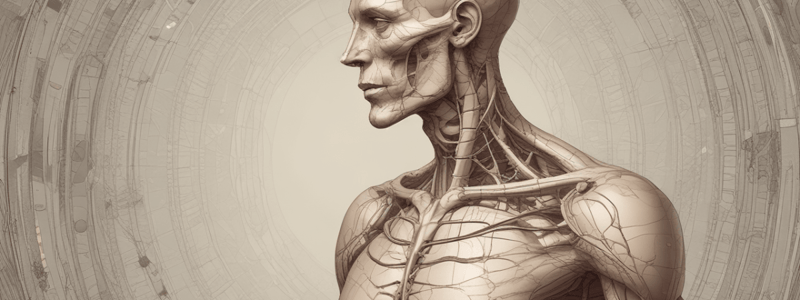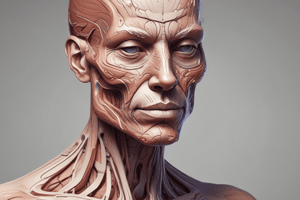Podcast
Questions and Answers
What type of cartilage is found covering the articular surfaces of bones in secondary cartilaginous joints?
What type of cartilage is found covering the articular surfaces of bones in secondary cartilaginous joints?
- Hyaline cartilage (correct)
- Elastic cartilage
- Fibrocartilage
- Dense connective tissue
What is the primary function of synovial fluid in synovial joints?
What is the primary function of synovial fluid in synovial joints?
- To absorb shock and stress on the joint
- To produce a protective layer around the joint
- To provide structural support to the joint
- To lubricate the articular surfaces of the bones (correct)
What is the term for the arrangement of fibrocartilage interposed between the articular surfaces of bones in certain synovial joints?
What is the term for the arrangement of fibrocartilage interposed between the articular surfaces of bones in certain synovial joints?
- Ligamentous connections
- Cartilaginous pads
- Articular discs (correct)
- Synovial folds
What is the purpose of bursae in the body?
What is the purpose of bursae in the body?
What type of tissue makes up the majority of ligaments?
What type of tissue makes up the majority of ligaments?
What is the term for the fibrous sac that surrounds the joint cavity in a synovial joint?
What is the term for the fibrous sac that surrounds the joint cavity in a synovial joint?
What type of movement is possible in secondary cartilaginous joints?
What type of movement is possible in secondary cartilaginous joints?
What is the term for the cord or band of connective tissue that unites two structures?
What is the term for the cord or band of connective tissue that unites two structures?
What is the function of the synovial membrane in synovial joints?
What is the function of the synovial membrane in synovial joints?
What is the characteristic of the second type of ligaments?
What is the characteristic of the second type of ligaments?
Flashcards are hidden until you start studying
Study Notes
Skin
- Divided into two parts: epidermis (superficial) and dermis (deep)
- Epidermis is a stratified epithelium; thick on palms and soles to withstand wear and tear
- Dermis is composed of dense connective tissue containing blood vessels, lymphatic vessels, and nerves
- Connected to underlying deep fascia or bones by superficial fascia (subcutaneous tissue)
- Appendages of skin include nails, hair follicles, sebaceous glands, and sweat glands
Fasciae
- Two types: superficial and deep
- Superficial fascia (subcutaneous tissue) is a mixture of loose areolar and adipose tissue
- Deep fascia is a membranous layer of connective tissue investing muscles and other deep structures
- In neck, forms well-defined layers; in thorax and abdomen, a thin film of areolar tissue covering muscles and aponeuroses
Muscle
- Three types: skeletal, smooth, and cardiac
Skeletal Muscle
- Produce movements of skeleton; sometimes called voluntary muscles
- Made up of striped muscle fibers
- A skeletal muscle has two or more attachments: origin (moves least) and insertion (moves most)
- Attachments may be reversed; terms origin and insertion are interchangeable
- Fleshy part of muscle is referred to as its belly
- Ends of a muscle are attached to bones, cartilage, or ligaments by tendons or aponeurosis
- Raphe is an interdigitation of tendinous ends of fibers of flat muscles
- Skeletal muscle action:
- Prime mover: chief muscle or member of a chief group of muscles responsible for a particular movement
- Antagonist: opposes the action of the prime mover
- Fixator: contracts isometrically to stabilize the origin of the prime mover
- Synergist: contracts to stabilize intermediate joints, allowing prime mover to act on main joint
Nerve Supply of Skeletal Muscle
- Nerve trunk to a muscle is a mixed nerve (60% motor, 40% sensory)
Smooth Muscle
- Consists of long, spindle-shaped cells closely arranged in bundles or sheets
- Provides motive power for propelling contents through lumen in tubes of the body
- Causes ingested food to be thoroughly mixed with digestive juices in digestive system
- Fibers are irregularly arranged and interlaced; contraction is slow and sustained
- Found in walls of blood vessels, serving to modify the caliber of the lumen
Cardiac Muscle
- Consists of striated muscle fibers that branch and unite with each other
- Forms the myocardium of the heart
- Fibers tend to be arranged in whorls and spirals, with property of spontaneous and rhythmic contraction
Joints
- A site where two or more bones come together, whether or not movement occurs between them
- Classified according to tissues between bones: fibrous, cartilaginous, and synovial joints
Fibrous Joints
- Articulating surfaces of bones joined by fibrous tissue, allowing very little movement
- Example: sutures of the vault of the skull
Cartilaginous Joints
- Bones united by a plate of fibrocartilage; articular surfaces covered by a thin layer of hyaline cartilage
- Small amount of movement is possible
- Example: joints between vertebral bodies
Synovial Joints
- Articular surfaces of bones covered by a thin layer of hyaline cartilage, separated by a joint cavity
- Allows a great degree of freedom of movement
- Cavity of joint is lined by synovial membrane, which extends from margins of one articular surface to those of the other
- Protected on the outside by a tough fibrous membrane referred to as the capsule of the joint
- Articular surfaces lubricated by synovial fluid, produced by synovial membrane
- Discs or wedges of fibrocartilage (articular discs) may be interposed between articular surfaces of bones
Ligament
- A cord or band of connective tissue uniting two structures
- Commonly found in association with joints
- Two types: dense bundles of collagen fibers (unstretchable) and elastic tissues (can regain original length after stretching)
Bursae
- A lubricating device consisting of a closed fibrous sac lined with a smooth membrane
- Walls separated by a film of viscous fluid
- Found wherever tendons rub against bones, ligaments, or other tendons
- Commonly found close to joints where skin rubs against underlying bony structures
Studying That Suits You
Use AI to generate personalized quizzes and flashcards to suit your learning preferences.




